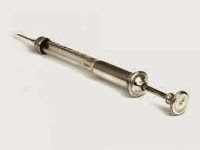However, syringes are, in fact, better than taking oral medicine. The medicine we swallow would take some time to reach the stomach, and it would also take more time to enter the bloodstream to reach the organ that it intends to heal. Because of the slowness of oral medicine, it is not suitable for treatments that need immediate effects on the body. In these cases, the medicine must be applied urgently, and that is where the syringes come into the picture. A syringe has a hollow needle at the tip of the medicine tube, and the hollow part of the needle allows the medicine to flow through it and into the injected area of the body. In addition, through the use of the hollow needle, bodily fluids like blood can be extracted and transferred to the syringe as well.
The practice of injecting medicines into the body has quite a long history. The concept of injection is said to have originated from as early as the 2nd century AD. According to historical records, the controversial doctor named Galen used to inject medicine directly into the brain of his patients. In the 17th century, various scientists had indulged themselves in experiments using syringes and studied the effects of injected substances into the body. During his experiments on the organs found in the circulatory system, English physician William Harvey used to inject various colored liquids into blood vessels. All the injection systems developed back then had a major drawback. The problem for the injections in that time is that they could be applied only through a natural opening, such as the nose and the mouth, or a wound on the body. Because doctors back then believed that injecting medicine on wounds is more effective in curing illnesses, they used to make small cuts on the body for injections, which was considered a dangerous practice.
In 1844, an Irish doctor by the name of Francis Rynd developed the hollow needle, an invention that changed how syringes were used. The doctor claimed to have injected drugs into a woman using his invention, and he then reported that there were no side effects in his procedures. A few years later, the French doctor Charles Gabriel Pravaz entered the scene with his own creation, the hypodermic syringe. Hypodermic means “anything beneath the skin.” The term was actually coined in 1858 by Dr. Charles Hunter, a physician who would later realize that injecting morphine on the body could numb and relieve pain, and the relief would have the same effect wherever you inject the drug.
Pravaz’s hollow needle, which was made of silver, was about 3 centimeters in height and 5 millimeters in diameter. The doctor had to only push the piston at the back of the syringe in order to inject the medicine once the needle is inside an area of the body. On the other hand, if the piston was drawn back, a small amount of blood could be collected in the syringe. Pravaz’s needle was invented in 1853, a few years before the term “hypodermic” was coined. Around the same time, a Scottish doctor named Alexander Wood also invented a syringe with an identical appearance. Although Pravaz did his best to make his hollow needle known in the field of medicine, it was Wood who actually made the syringe popular over the world. He used the syringe to inject drugs into patients to prove that it is effective. Unfortunately, he became obsessed with injecting himself with morphine and got addicted to it along with his wife. The news of his addiction went out of hand during that period, and there were even reports that he accidentally killed his wife after overdosing her with morphine. However, the story was proven to be a lie, as his wife outlived him by more than ten years. Alexander Wood died in 1884, while his wife died in 1895.
Despite the controversies surrounding Wood’s life, his syringe still became one of the most used medical equipment in the world. In fact, many people tried to improve its function years after his death. In 1949, the Australian inventor Charles Rothauser created the world’s first disposable hypodermic syringe, and in 1956, veterinarian and pharmacist Colin Murdoch made the first fully disposable syringe made of plastic as well.
Related posts:

